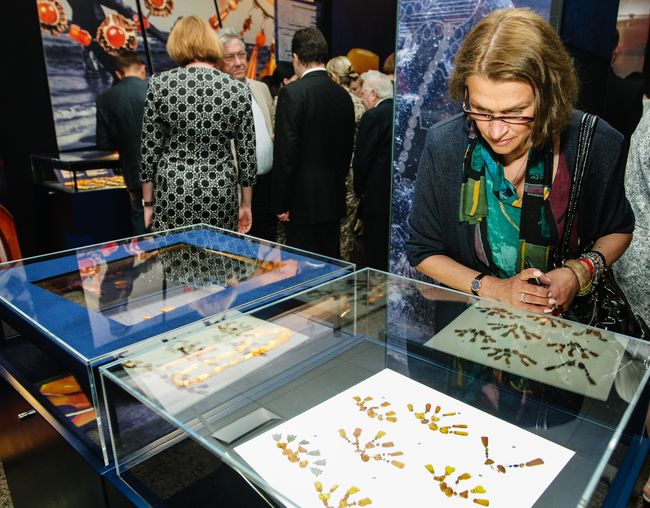Latvia’s history in amber
The Kyiv City History Museum launches a project on the famous Baltic gem
Honey- and sun-colored fibula clasps, necklaces, earrings, and buttons seem to be shining in a dark room. The exhibit “Amber: the Baltic Sea’s Precious Stone” displays almost 200 items from the National Museum of Latvian History. Some stones date back to the 3rd millennium BC (!), there are also 17th-century decorations and massive necklaces made by present-day masters. The exhibit is part of the cultural program of the Latvian presidency of the EU Council. In Ukraine, the project is sponsored by the Latvian Embassy, the Ministry of Culture, and the Kyiv City State Administration.
The exhibit’s star attraction is an amber pendant made in the Late Stone Age period (6th-4th millennia BC). The small ornament resembles a grass snake, a woman, and a cloud – researchers are still racking their brains over what it really is. Next to it is the small head of a moose, also made in the Stone Age. The figure’s verisimilitude is impressive. But it is only a fragment – there is a fissure under the neck, which means that a part of the amber moose was lost. A heap of dark-crusted uncut amber is a trove found near Riga in 1972. The treasure, which weighs more than 25 kilograms, is the largest gemstone of this kind ever found in Eastern Europe. Latvian amber is a gift of the sea.
“Our brand is not excavated – the sea splashes it out. After a storm, people pick up gemstones on the Baltic Sea shore,” says Irina Zeibarte, deputy director (research) of the National Museum of Latvian History, the exhibit curator. “Generations of masters have been processing gems. It is a handicraft industry that turned into an applied art.”
The technology of cutting amber has not much changed over the millennia – masters use almost the same drills and polishing tools that their ancestors did.
There are many traditions associated with this gemstone. Amber has long symbolized the sun, so it has been used to make ornaments and amulets for millennia on end. People were proud to have objects made of it, even small brooches, and handed them down from generation to generation. In Latvia, amber is also often mentioned in folk songs.
The museum displays ancient gems by means of up-to-date territories. For example, the floor is fitted with an interactive map of the Amber Way down which gemstones were transported. When a visitor steps on the map, it illuminates a certain country. If nobody stands on the map, it just shows a swashing sea. The exhibit also has holograms of valuables and people in amber-adorned folk costumes. Martin PREDDITYS, a representative of the company that has equipped the exhibit with multimedia devices, says: “We were preparing this exhibit for at least six months. Our company deals with audiovisual technologies, and we design and put into practice multimedia projects – it is in fact an innovation.”
Past year the amber exhibit was staged in Riga, and this year the project has been shown in Minsk and now in Kyiv. After the show, the collection will be put into the National Museum of Latvia’s repository for a few years – the gemstones should “have a rest” after traveling in a changeable climate. The museum is going to show this exhibit elsewhere in the world. “We are presenting not only our collection, but also our state. We want visitors not only to see some beautiful things, but also to know what represents a value for our people,” Ms. Zeibarte emphasizes.
The exhibit “Amber: the Baltic Sea’s Precious Stone” will remain open at the Kyiv History Museum until June 30.
Newspaper output №:
№36, (2015)Section
Time Out





